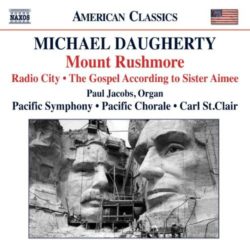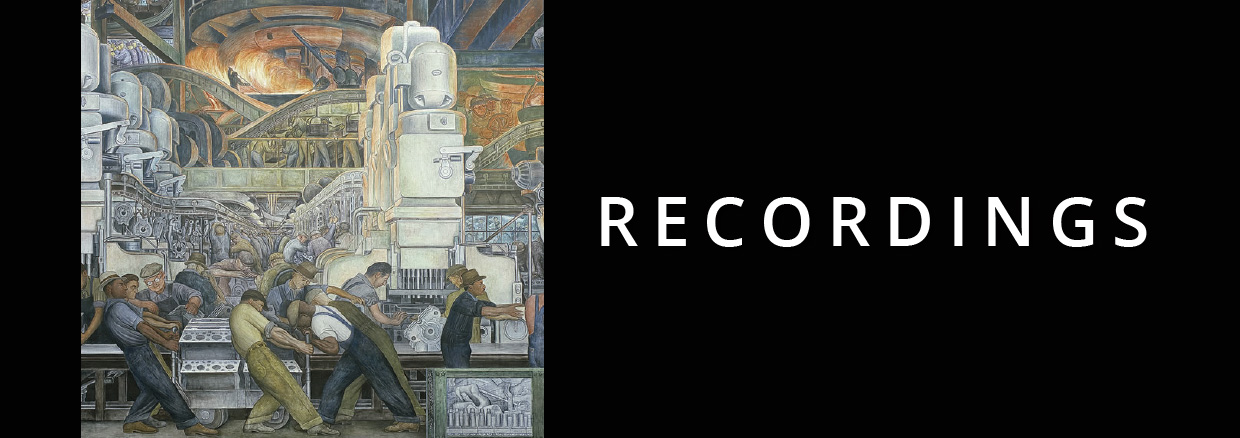Mount Rushmore
Naxos/April 2013
Mount Rushmore/Radio City/The Gospel According to Sister Aimee
Paul Jacobs, organ
Pacific Symphony
Carl St. Clair, conductor

REVIEW FROM MUSICWEB INTERNATIONAL, AUGUST 2013:
The last time I saw Mount Rushmore Eva Marie Saint was hanging off it in North by Northwest, and the last time I heard the music of Michael Daugherty was in AmericanSpectrum. As for the California-based Pacific Orchestra and Chorale and their conductor Carl St Clair, they are new to me; however, the blurb speaks glowingly of a new ensemble dedicated to promoting contemporary music as well as playing the core classics. The works on this disc, written between 2010 and 2012, are certainly bang up to date, so kudos to Naxos for wasting no time in committing them to disc.
In my review of Daugherty’s musical evocation of the iconic Sunset Strip I noted that he has a ‘penchant for celebrating places and spaces’; well, the huge presidential portraits carved into the Black Hills of South Dakota are about as iconic as it gets. In his very readable liner-notes the composer explains his choice of texts, ranging from the letter Washington wrote on his retirement and a lover’s song for Jefferson to Roosevelt’s musings on the great outdoors and Lincoln’s Gettysburg Address. In that sense the work is a genuine – and very affectionate – traversal of American history.
George Washington opens with breathtaking power, and the orchestra and organ are joined by choirs whose songs of the period are projected with telling ardour and accuracy. Daugherty’s strong, sinewy rhythms and his transported choral writing in Thomas Jefferson recall Prokofiev’s Alexander Nevsky, the quieter passages Britten at his most reflective and intimate. Not surprisingly the adventurer Theodore Roosevelt strides forth to strong orchestral accents and horizon-stretching choral vistas; there’s even an Orffian earthiness to the more declamatory moments. The music of Abraham Lincoln – noble and visionary – seems to catalyse all that’s gone before; in the broad, slow-building finale, shot through with jubilant bells and punctuated by trenchant rhythms, Daugherty strikes just the right balance between grandeur and gravitas.
Mount Rushmore is a terrific piece, as much a contribution to musical Americana as anything by Copland or Thomson. Moreover, it’s played with tremendous verve and passion by St Clair and his multitude of musicians, and the recording’s wide dynamics are very well caught by the Naxos engineers. There are hints of other ages here, but this is no clumsy, derivative pastiche; no, Daugherty speaks with an assured and individual voice that deserves to be more widely heard.
New York’s Radio City, the home of Arturo Toscanini and the NBC Symphony, is the second landmark to be celebrated here. It’s also a homage to the fiery maestro, whose first NBC concert is evoked in the Vivaldian echoes and emphatic thrust of O, Brave New World. Daugherty has a lively and inventive style and the Pacific band give this music all the crunch and punch it needs, before modulating into the equally forthright yet sometimes dreamily nostalgic Ode to the Old World that follows. Happily there are no longueurs to speak of, and listeners of all stripes will surely respond to the fine writing on display here and in the witty Toscanini portrait, On the Air.
Daugherty then turns his attention to another icon, Aimee Semple McPherson, who he calls ‘the first important religious celebrity of the new, mass-media era of the 1930s’. Anyone remotely familiar with the antics of modern tele-evangelists as embodied by Billy Graham and many others since will smile – even laugh out loud – at the exaggerated organ glissandi and burping revivalist brass of Knock Out the Devil. This is a fiendishly clever piece of writing that captures to perfection that weird blend of strained piety and outrageous theatre that accompanies these preachers and their very public ministry. Organist Paul Jacobs tackles his riotous part with obvious glee and the Pacific brass have a field day too. SurelyThe Gospel According to Sister Aimee is the modern-day equivalent of Ives’s equally satirical General William Booth Enters into Heaven; both are just too accurately drawn to be offensive.
I enjoyed this disc so much I barely noticed the sweltering summer heat outside. This is highly original music that avoids mawkishness in the first two pieces and is so deftly drawn in the third as to signal a composer of accomplishment and good judgement. Daugherty’s chatty liner-notes are part of the whole entertainment, and the sonics are simply awesome.
A well-chosen programme that highlights Daugherty’s prodigious talent; great fun.
~Dan Morgan
REVIEW FROM CLASSICS TODAY:
Michael Daugherty continues his musical exploration of iconic bits of Americana on this highly entertaining disc containing premiere recordings of three major works. Mount Rushmore is a cantata for chorus and orchestra in (aptly enough) four movements, each of which sets a text mostly by the president depicted in each of the mountainside’s four massive busts. Happily Daugherty creates variety by choosing a wide range reference. Thomas Jefferson, for example, contributes an Italian love song, while Lincoln is represented by the Gettysburg Address. The text setting is largely syllabic, and it would be idle to pretend that Daugherty shows much imagination in his handling of the vocal parts, but the scoring is brilliant and the work is much more than mere patriotic puffery (as the introspective ending shows).
Radio City, a three-movement “Symphonic Fantasy on Arturo Toscanini and the NBC Symphony”, isn’t the first musical portrait of the great Italian maestro. That honor probably belongs to Don Gillis’ eponymous tone poem, which has yet to be recorded. Indeed, Gillis is the composer who Daugherty most often resembles in his “pop meets classical” aesthetic, although Gillis wins out in terms of sheer humor. Still, Radio City is a bravura vehicle for the orchestra. The opening movement casts a glance at Vivaldi and Verdi without ever descending into cheap pastiche, and it’s a tribute to Daugherty’s strength of personality that he always sounds more like himself than anyone else.
The Gospel According to Sister Aimee is another triptych, this time paying tribute to early-20th-century evangelist Aimee Semple McPherson. A controversial figure, McPherson amassed a huge following while arousing widespread suspicion for supposedly staging her own disappearance so as to run off with one of her alleged lovers, before dying some years later from an accidental overdose of sleeping pills. Brilliantly scored for organ, brass, and percussion, with the organ part vividly played by Paul Jacobs, the piece obviously comes from the same pen as the other works on the program. However, by the time I got to this last work I couldn’t help but notice one of the shortcomings of Daugherty’s language: the near total absence of counterpoint.
Tovey famously remarked of Berlioz that he “achieved everything that was possible for a composer who hated counterpoint,” and enjoyable as this music certainly is, you may well come to feel similarly about Daugherty. Certainly in a work featuring the chorus, or the organ, or both, there’s a great opportunity to indulge in some extended polyphony, even if it isn’t strict (as in a formal fugue). However exciting the performances are, and there’s no question that Carl St. Clair and the Pacific Symphony and Chorale do a splendid job, the music would benefit from a touch more textural variety to lend substance to its tuneful, splashy timbral surface. Of course this is a purely personal opinion, one that should not detract from the appeal of this otherwise beautifully engineered release.
~David Hurwitz
